
About Cloudtail
Cloudtail India is a joint venture between Amazon and NR Narayana Murthy’s family office, Catamaran Ventures. Cloudtail India pvt ltd is an online retailer which sells variety of goods to customer in India. Cloudtail offers over 6 lakh products across multiple categories like Books, Media, Apparel, Shoes, Furniture, Appliances, Consumables etc. and has buying relationships with brands across the world. It is one of the largest sellers on the Amazon India online platform.
We have 2 integrations available for Cloudtail.
1. Cloudtail DF (Direct Fulfilment)
2. Cloudtail B2B.
This document is all about the Cloudtail Direct fulfillment Program and its integration with Vin e-Retail.
What is Direct Fulfillment?
Direct Fulfillment is a supply chain strategy whereby the retailer (Cloudtail) transfers individual customer orders to the supplier (Brand/Seller) to ship the goods directly to the end customer.
Below are the key features of Cloudtail DF Program:
1. Cloudtail DF is Bill to Ship to Model in which Customer places order on Amazon (where Cloudtail is a seller).
2. When the order is received to Cloudtail, Cloudtail directly Passes that orders to the Brands/Sellers and Brands are doing the fulfilment on behalf of Cloudtail.
3. Orders are created on the price agreed between Cloudtail and Brand (Not on the Sale price of the customer). 4. the Shipping Labels are invoices are generated where the Sold By/Ship from is Cloudtail.
Vin E-Retail Integration with amazon cloudtail
For this Model, we have:
1. SKU Pull (Using Amazon MWS APIs) as Cloudtail does not have any such API.
2. Order Pull
3. Order Acknowledgements
4. Order Pack/Invoice/Shipping Label generation
5. Order Shipment
6. Inventory Push
This Model is running with around 15-20 brands i.e. Paragon, Soch, Bagzone (Lavie), Planet Retail, Harpa, Clovia etc since last 8-10 months.
Prerequisites for Channel Configuration
Below mentioned Credentials are mandatory and are required to configure Cloudtail DF for any client.
1. Cloudtail Vendor Id
5 characters Vendor Id (This credential will be shared by Cloudtail account manager to the Brand/seller) once the commercials are done between Seller/Brand and Cloudtail.
2. Cloudtail Warehouse Id
4 Characters Warehouse Id/FC Id (Warehouse Identified of Cloudtail) and this credential will be shared by the Cloudtail account manager to the Brand/Seller.
3. Amazon Cloudtail Vendor Id
This can be created by Vinculum’s account Manager and is a mandatory attribute to be used in multiple API of Cloudtail. This can be created by using the 5-charater Cloudtail Vendor Id and the format is: – amzn1.vendor-id.AB1CD where AB1CD is the vendor Id shared by Cloudtail to the seller and amzn1.vendor-id. Is fixed.
Optional Credentials:
All MWS credentials i.e. MWS Seller Id, MWS Token, Access Key, Client Secret and Marketplace Id are optional and are required If and only If the seller wants to enable the Auto SKU Pull in Vin e-Retail.
Please use the same MWS credentials using which the seller has configured Amazon account in Vin e-Retail.
SKU Pull is applicable only if the client using Amazon also. If the Client is a Cloudtail vendor only than the SKU Pull is not applicable.
Process to Generate MWS Access Key:
- Login on https://sellercentral.amazon.in or any other country domain link. (Example for Amazon US it is https://sellercentral.amazon.com).

2. Enter the Username and Password.
3. Approve Notification and enter OTP details.

4. Go to “Settings” and select “User Permissions” as mentioned in the screenshot below.
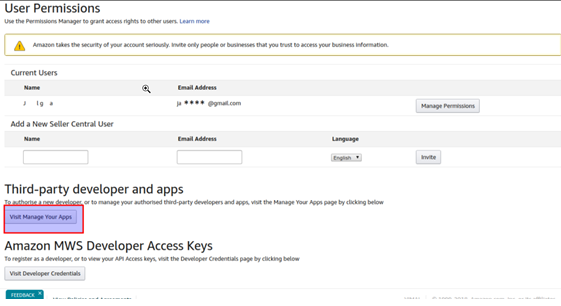
5. Click on “Visit Manage your Apps” under “Third party Developer and Apps” section.

6. Click on “Authorize new Developer” Button.

7. Enter the Developer name and Developer ID as per the information provided below:
- Developer Id is: 073980952359; Developer name: vinculum (For India, UK, MEA, Japan and other countries except US and Australia)
- Developer Id: 18802594138; Developer name: vinculum (US)
*Developer ID and Developer name should not be with any space and Developer name should be in small caps always.
8. Once the Developer Name and Developer Id is entered, we will click on the “Next” Button, Merchant Id (Seller ID), MWS Token and Marketplace Id will be generated.
*These IDs are confidential and hence cannot be shown in this document.
CHANNEL CONFIGURATION
- Once all the above IDs are gathered, open your vin e-retail instance (ERP)
- Go to “Manage Channels” in “Sales” Section.

2. Go to the top right-hand side of the window and Click on “Add New.”

3. Select “Cloudtail DF” window from the list.
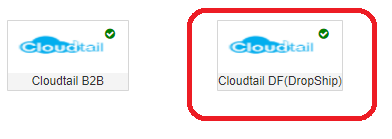
4. After selecting the option, below “Channel Maintenance” window will appear.
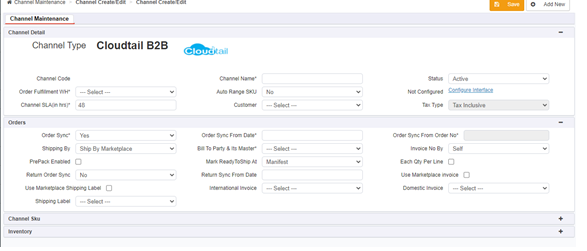
5. Fill all the details like Channel Name, order Source WH, Order Sync from date, Return Sync from Date, Inventory Sync Method, Enable Inventory Reconciliation etc.
6. Click on “Configure Interface.”

7. Enter the details:
- Cloudtail Vendor ID
- Cloudtail Warehouse ID
- Amz-Cloudtail Vendor ID (ex. Amzn1.vendor-id.AB1CD)
If SKU Pull is required then use the same MWS credentials using which the seller has configured Amazon account in Vin e-Retail.
Channel Mappings:
Currently in case of Amazon Dropship model that we have we/client maps the Merchant SKU code of Amazon in ChannelSKUcode of eRetail. In case of Cloudtail DF, we also must Map the Merchant SKU/Amazon SKU in ChannelSKUcode and ASIN needs to be mapped in ChannelProductId.
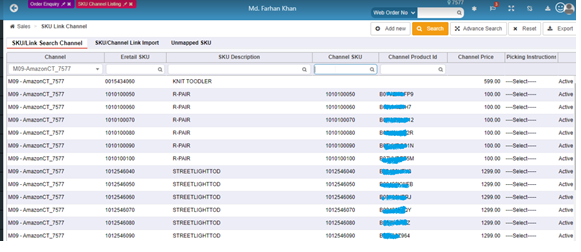
CHANNEL MAINTENANCE
Channel Maintenance set up helps the seller to reduce manual intervention and avoid the multiple usage of marketplace seller portal. With the selection of below options at Channel Maintenance window (Sales>Manage Channels>Add New>Select Amazon India) get the advantage of using multiple features of Vin E-retail:
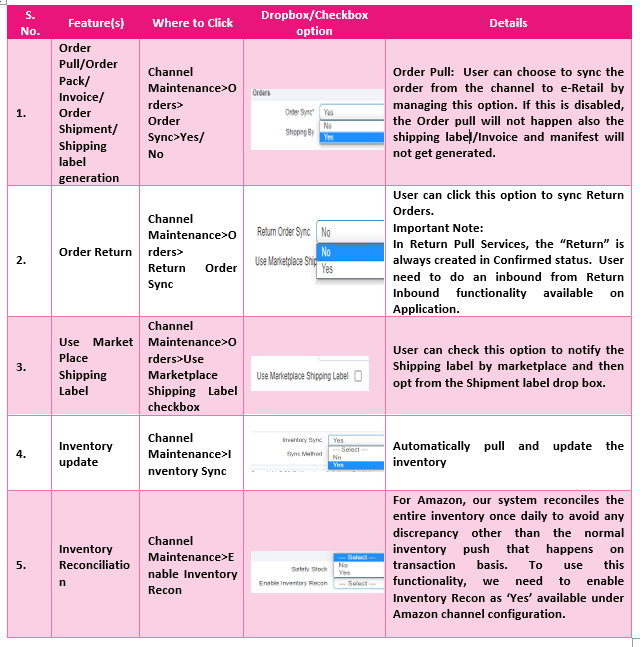
Additional Key Information:
1. We get the orders of last 24-48 hours from the Cloudtail APIs. So please set the Order Pull from date in the channel configuration screen accordingly.
2. If the order Pull from date exceed the mentioned range, the orders will not be pulled. Likewise, other Marketplaces Ex: Amazon Flex, we sent the acknowledgement at order Allocation. In case of Cloudtail DF, Vin e-Retail sent the order Acknowledgements at the time of Order Invoice.
3. Cloudtail shipping labels have .pdf format. However, the Shipping Labels has the. ZPL format which means the Brand/Seller not able to preview the Shipping document in Browser and auto Print configuration is a must have feature for Cloudtail DF Shipping label and Invoice generation.
4. In case of Cloudtail DF, if an order has 5-line items, then 5 shipping labels will be generated on Vin e-Retail back to back on a single click on Print Label Button.
5. Client must input the actual weight and dimensions of the package at the time of Order Pack or Order Prefetch.
6. Orders should be marked as shipped only if they are handed over to courier partner. (Making the order shipped before the actual handover will lead to miss communication.)
